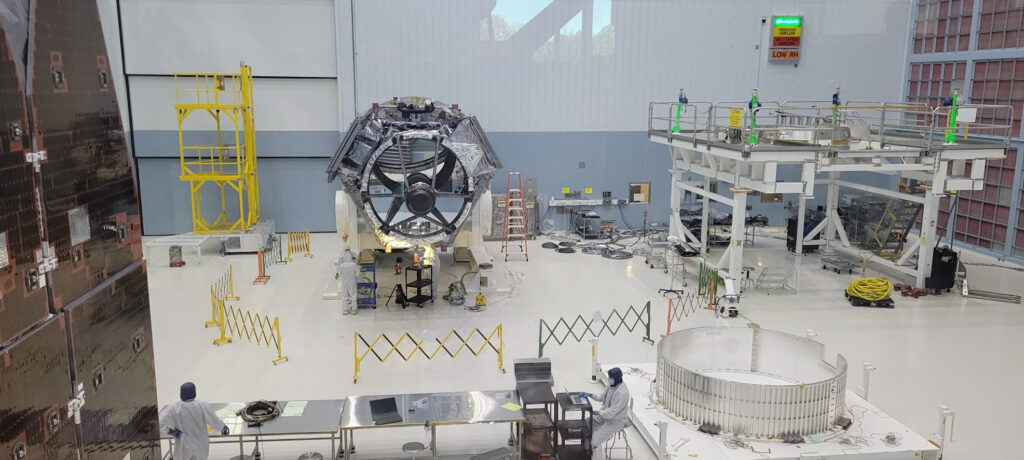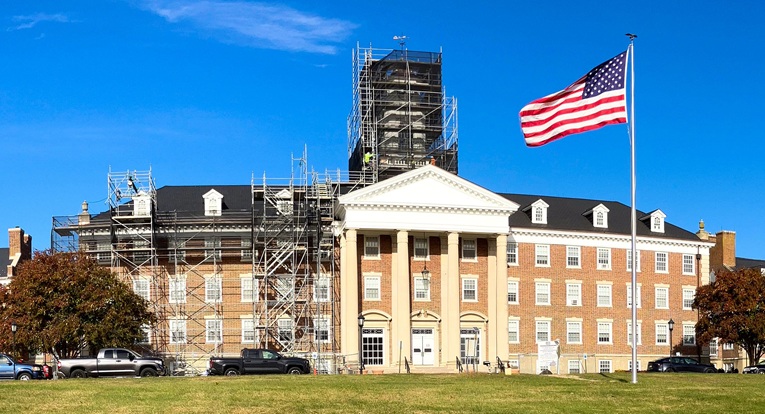On November 6 we reported that federal workers at NASA’s Goddard Space Flight Center (GSFC) were being recalled during a government shutdown to clear offices. On November 13 we reported that Zoe Lofgren (D-CA), ranking Democrat on the House Science, Space and Technology Committee, sent a letter on Monday, November 10, ordering a halt to the closures, though our sources reported movers took equipment from Building 11 throughout the day on Wednesday, November 12. The packing up of labs in that building continued Thursday and Friday, says a News Review source who works there. GSFC leaders have denied lost capabilities but on Tuesday confirmed plans to vacate the buildings west of Goddard Road.
On November 13 Maryland Delegation members ‒ including U.S. Senators Chris Van Hollen and Angela Alsobrooks and U.S. Representatives Steny Hoyer, Kweisi Mfume, Jamie Raskin, Glenn Ivey, Sarah Elfreth, April McClain Delaney and Johnny Olszewski (all D-Md.) ‒ joined the call for information about actions underway at Goddard. “We have heard from employees and read reports about activities taking place on the Greenbelt campus that have raised questions among the workforce about the motivations and timing of building consolidations and such moves may affect institutional research capabilities,” the lawmakers wrote. Their letter included a series of questions about GSFC building consolidations, the impact on the Center’s technological capabilities, readiness for future scheduled missions, employees tasked with carrying out operational changes during the government shutdown and what the facilities changes have been.
On November 14, a letter from Acting Director of GSFC Cynthia Simmons and Associate Administrator for the Science Mission Directorate Nicola Fox responded to Lofgren’s letter and insisted her assertion that Goddard is being dismantled “could not be further from the truth.” Simmons and Fox wrote that operating under continuing resolutions, coupled with rising operations and maintenance costs, have necessitated consolidations and efforts to reduce costs, which have been ongoing for over five years. The work to reduce costs “is being carefully coordinated with the mission project managers of the critical missions currently in development to avoid impacting schedule and/or increasing costs,” their letter said.
On Goddard’s campus, however, multiple sources expressed frustration to the News Review that center leadership is denying capabilities are being lost. In contrast to the assertions of careful coordination, this week several workers in impacted buildings still do not know where they or their equipment are being moved to and described chaotic packing with little notice.
The International Federation of Professional and Technical Engineers (IFPTE), Goddard Engineers, Scientists and Technicians Association’s (GESTA’s) parent union, has produced a white paper that documents the impact of closures, moves and divestments at GSFC. IFPTE has titled the brief “NASA Goddard is Destroying Strategic Capabilities Needed for NASA Missions by Closing Buildings and Divesting Labs.” In it the union asserts that GSFC began acting to close 13 buildings on the west side of the campus around September 23, shortly before the shutdown (see the September 25 issue). Those plans included emptying or displacing nearly 100 laboratories and “in many cases, discarding unique and valuable labs, equipment and materials.”
The News Review has independently verified the divestment of some valuable government equipment from GSFC. Entire buildings have been closed in a week, reports IFPTE, with little planning, destinations for items emptied out unknown a week in advance, and government workers and contractors called in to move items and close buildings during the shutdown, some given just 48 hours to pack up offices, they allege. The deadline to empty all 13 buildings is March 2026, says IFPTE, a timeline confirmed in an email from Simmons to GSFC staff on Tuesday afternoon. “The unplanned and destructive speed of these building closures is already resulting in the loss of capabilities that are needed for high-priority current and future missions,.
As the closures advance, the scope of the damage continues to grow,” claims IFPTE, which also cites a “loss of millions of dollars in taxpayer-funded laboratory facilities, including sophisticated and high value equipment that will be difficult, if not impossible, to replace.” Our sources also expressed concern over potential damage to the equipment that is being moved without the expected oversight or professionalism.
The Impact on Missions
A sampling of the current missions IFPTE details as impacted by GSFC closures includes Artemis III, America’s crewed mission to the moon, whose Thermal Technology Development and Demonstration Facility was housed in Building 4. Also impacted is the Roman Space Telescope, which was being worked on in Buildings 11 and 20 and some of whose equipment and hardware was being housed in Building 11 when the team was given seven days’ notice of its move-out plans, according to IFPTE. “The location of some Roman equipment and parts that were housed in Building 19, which has now been locked and closed, is currently unknown,” states IFPTE’s brief.
Also impacted is the Lunar Environment Monitoring Station, a network of seismometers destined for the lunar South Pole on Artemis III, which was utilizing Buildings 4, 20 and 21. Dragonfly, the rotorcraft lander to explore Saturn’s moon, Titan, had hardware development, testing and assembly underway in Building 11 and scheduled testing in labs in Buildings 20 and 4. DAVINCI, an orbiter and atmospheric probe for Venus, is also impacted by the closure of Buildings 11, 4 and 19. The Habitable Worlds Observatory, a large space telescope, had development underway in Building 11 and the Geodetic Reference Instrument Transponder for Small Satellites had equipment and parts that were in Building 19, whose status and location are now unknown.
Impact on Strategic Capabilities
IFPTE outlines seven strategic capabilities impacted by the building closures at Goddard. They are the Goddard ElectroMagnetic Anechoic Chamber in Building 19; the Microwave Electronics Test and Assembly Laboratory in Building 19; the Digital Communications Laboratory in Building 19; the Power Systems Branch and Solar Array Laboratory in Building 20; the Detector Development Laboratory and Detector Characterization Laboratory in Building 11; the Propulsion Lab and Cleanroom in Building 11; and the Heliophysics Science Division in Building 21.
The closures and moves “will severely reduce America’s ability to be competitive in science and technology in the future,” asserts IFPTE.
Communication About Closures
“There is no official list [of the buildings that have been closed to date or that are planned for closure] since none of this has been planned or communicated in advance,” one GFSC scientist told the News Review Tuesday morning. Such a list is among the requests from the Maryland lawmakers. Goddard employees have been attempting to keep their own log of moves that are upcoming and what has been closed or emptied. On the afternoon of Tuesday, November 18 Simmons confirmed the leadership’s plan is to vacate buildings west of Goddard Road in an email to GSFC employees.
“After first announcing this [campus transformation] effort to you all in late September, the lapse in appropriations prevented us from a series of communications we had planned for October,” wrote Simmons. The email pointed to the GSFC Master Plan, saying it calls for a 25.1 percent reduction in square footage by 2037. Goddard is a center of approximately 6,600 people, down from 10,000 at its peak, explained Simmons, citing a “steady decline” in contractor workforce followed by “significant civil servant departures” this year due to the Deferred Resignation Program.
“It best serves our interest to prioritize investment,” wrote Simmons. “In general, at Greenbelt we are looking to vacate the buildings west of Goddard Road, and consolidate our presence east of Goddard Road. The buildings on the west side of campus will either be made available for lease to other government agencies or partners, or demolished if they have outlived their useful life. Those are ultimately Agency-level decisions,” Simmons wrote in her email.
The moves are now planned to be completed by March 2026, she confirmed and said they will reduce annual operating costs by approximately $10 million.
Lawmakers’ Concerns
“Unfortunately, actions taken during the last nine months threaten the workers at Goddard and their ability to lead the world in this science and exploration. Between unnecessary voluntary separations, deferred resignations, reductions in force, and other pressure, thousands of civil servants and contractors are no longer working at GSFC,” noted Maryland Delegation members in their November 13 letter to NASA’s Acting Administrator, Sean Duffy.
“Other countries with space programs from our political allies to our adversaries have been recruiting our top scientists and researchers with massive salaries, research budgets, and the promise of stability. Where the U.S. has considered stepping back, China has made clear they are eager to step in,” asserted the Maryland lawmakers.
“We can and must re-invest in the people and centers that make America the global space leader and that starts with Goddard.”
A GSFC employee briefing with Fox and Simmons was planned for Wednesday, November 19.




